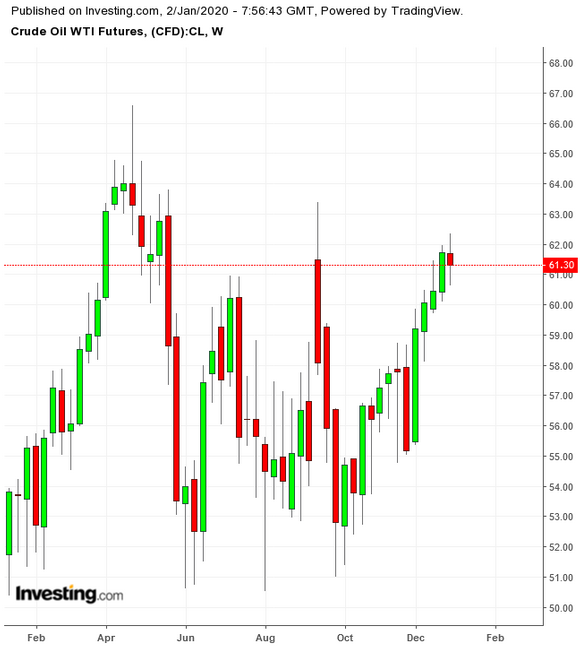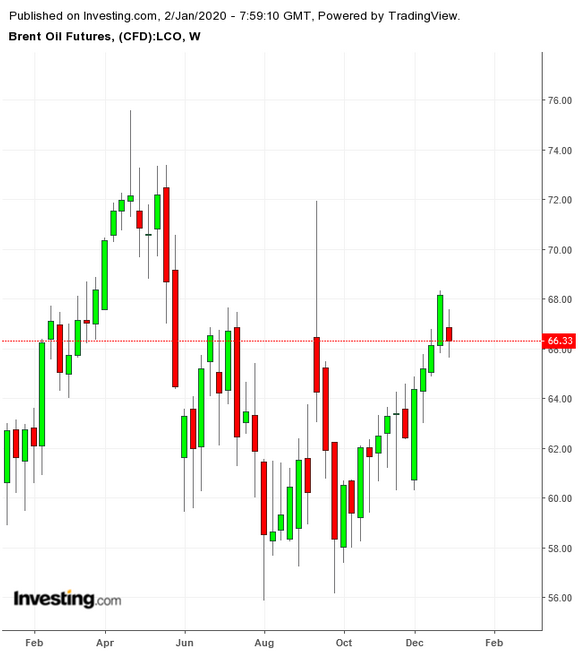Even before oil started 2020 trading, Donald Trump fed the market a China bull.
The U.S. president announced on New Year’s eve that the much-awaited preliminary trade deal between Washington and Beijing will be concluded in two weeks. "I will be signing our very large and comprehensive Phase One Trade Deal with China on January 15," Trump wrote in a standard caps-emphasized tweet.
"The ceremony will take place at the White House. High level representatives of China will be present. At a later date I will be going to Beijing where talks will begin on Phase Two!" he said, finishing with a customary exclamation mark.
Trump’s Pre-New Year Tweet Did Not Send Oil Higher
As excited as the president seemed about the impending deal, the news ought to have sent crude bulls into deliriums of joy and oil prices into a powerful rally.

Yet, New York-traded West Texas Intermediate, the U.S. crude benchmark, settled lower on the last trading day of 2019, down 62 cents, or 1.0%, at $61.06 per barrel. London-traded Brent, the global oil benchmark, lost 67 cents, also about 1.0% percent, to settle at $66.65 per barrel.
But Crude Still Had Huge Monthly, Quarterly And Yearly Gains
Despite that drop, the U.S. crude benchmark rose 11% for December, its largest monthly gain since January.

The U.K. crude standard settled up 7% for December, its largest monthly advance since April. For the year, WTI rose 34% while Brent had a 24% gain — the biggest annual gains since 2016 for both benchmarks.
So, why did crude bulls and their headline-reading algorithms ignore Trump’s New Year’s eve tweet on China? Wasn’t this the news the market had waited for all year? The trade war had restrained oil’s advance on many occasions, even resulting in selloffs despite geopolitical tensions and supply shortages.
Given the importance of China as the world’s No. 1 crude buyer — particularly as top importer of U.S. crude exports until the tit-for-tat tariffs between the two sides that began in mid-2018 — shouldn’t this tentative phase one deal have resulted in a positive Dec. 31 close for oil that would have been symbolic to its 2019 rally?
Yes, and no.
More Hype Than Fact Thus Far On Trade Deal
For all the hype of the phase one resolution, it must be remembered that it’s a deal that’s been long in the making. Oil prices, in fact, had a free run higher for the entire fourth quarter, after Trump began building expectations from early October that a signing was due between Washington and Beijing.
Wall Street’s entire year-end rally was presaged on the promise of the trade deal as Trump and his colleagues — comprising of White House Economic Adviser Larry Kudrow, Trade Representative Robert Lighthizer, Treasury Secretary Steve Mnuchin and Commerce Secretary Wilbur Ross — milked the market with constant updates that were long on hype and short on facts.
Oil prices alone rose 13% for the fourth quarter. That’s a big gain for a trade deal the market has yet to learn full details of, aside from Trump’s pre-New Year pledge that it will be “very large and comprehensive” agreement — adjectives not uncommon for this president.
That is not to say that oil prices will not continue rallying over the next two weeks until the signing.
Prices Could Maintain Their Upside On Trade Optimism
The market could very well run higher given the cloud over China’s economic outlook and oil demand that had been lifted for now by Trump’s announcement.
Data released last week by China’s National Bureau of Statistics revealed a significant improvement in profitability at industrial enterprises in November, with combined profits increasing 5.4%, year on year. That was quite a turnaround from the annualized fall of 9.9% in October.
The rebound came on the heels of better Chinese industrial production and retail sales data in November, supporting the notion of a broader-based economic recovery. More remarkably, the November improvement predated the December news of the phase one trade deal with the United States.
Chinese refineries have also been processing oil at record rates for most of this year, thanks in no small part to the addition of new refining capacity by independent companies, often called “teapots.” Bloomberg reported in March that this year will see total additions of almost 900,000 barrels per day in refining capacity, which will continue to drive demand.
There Is A Flip Side To The Bullish China Story Too
But China is also creating situations that could endanger the oil rally.
China’s first batch of oil product export quotas released for this year are 53% more than those for 2019, Reuters reports. At 28 million tons, the oil product export quotas will likely deepen an already serious glut of oil products on Asian markets that have eaten into refiner’s bottom lines. These quotas could come back to bite crude bulls in the butt.
Oil’s 2019 rally was largely helped by production cuts carried out by the Organization of the Petroleum Exporting Countries (OPEC). Since January, the Saudi-led OPEC, joined by its ally Russia under the OPEC+ alliance, has tried to enforce a daily production cut of 1.2 million barrels. In December, as that arrangement was about to expire, OPEC+ said it would deepen those cuts to 2.1 million barrels per day from the start of 2020.
Despite its plan for stiffer production cuts, OPEC+ could have a tougher time keeping oil prices up in 2020 as U.S. shale oil output may rebound next year, some long-time traders in oil have said. While U.S. crude production as a whole hit a record high of 12.9 million barrels per day in 2019, shale oil output — which accounts for more than half of U.S. total production — has been somewhat restrained this year. U.S. crude producers as a whole cut the number of actively-operating oil rigs in the country to 677 this year from 885 at the end of 2018 — a drop of 208 rigs or 24%.
Do Not Discount A Bounce Back In U.S. Shale Output
“The main reason for the 24% cutback in actively-drilling US oil rigs this year was the price uncertainty that persisted mid-year,” said John Kilduff, founding partner at New York energy hedge fund Again Capital. WTI hovered between $50 and $55 during most of the summer months, weighing on the broader oil market.
Kilduff said with the OPEC decision to double down on production cuts taking effect only in early December, it will take U.S. drillers some time to turn their spigots back on in full and plow ahead with production.
“With oil prices being the way they are, one can bet on more challenges ahead for production.”
Kilduff added, “WTI at above $60 is very, very remunerable to U.S. shale.”
Non-OPEC oil supply, led by the U.S. shale, is forecast to grow by 2.1 million barrels a day in 2020, according to the Paris-based International Energy Agency (IEA).
Global Need Could Be 900,000 Bpd Less
Global demand for oil, meanwhile, is set to increase by 1.2 million barrels a day next year, the EIA said. That means the world will need 900,000 fewer barrels of oil every day from both OPEC and non-OPEC producers alike, a situation that could sharply offset OPEC+ production cuts.
"The oil market continues to see robust crude oil production from the USA, Canada, and Brazil, which could lead to a supply glut in 2020," states a recent report from the Washington D.C. think tank the Institute of International Finance.
The report, written by a team led by Garbis Iradian, IIF chief economist for the Middle East and North Africa, forecasts world oil production to expand by 1.9 million barrels of oil a day in 2020 versus 2019. More than half that total will come from the United States. While that increase in supply is a little less than 2% of the total, the oil market is always finely balanced, so seemingly small changes in supply or demand can have a significant impact on prices.
World Tensions Could Lend Bulls A Hand Though
But oil bulls could also have one wild card in their favor: geopolitical tensions.
The U.S. military carried out air strikes against Iran-backed Kataib Hezbollah militia group over the weekend. Angry at the air strikes, protesters stormed the U.S. Embassy in Baghdad on Wednesday, although they withdrew after the United States deployed extra troops.
“A dash of geopolitical risk factors … should lend support to oil,” said Phil Flynn, an analyst at Chicago’s Price Futures, who’s typically bullish on crude.
